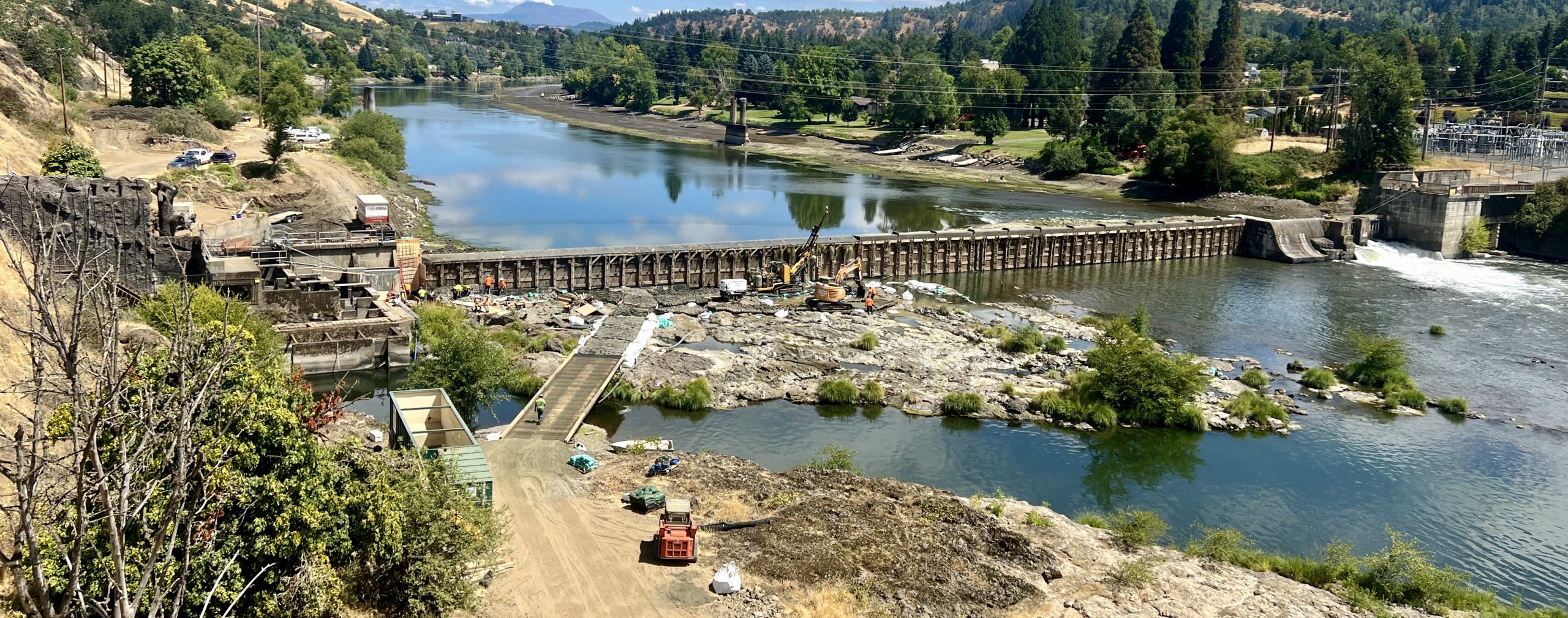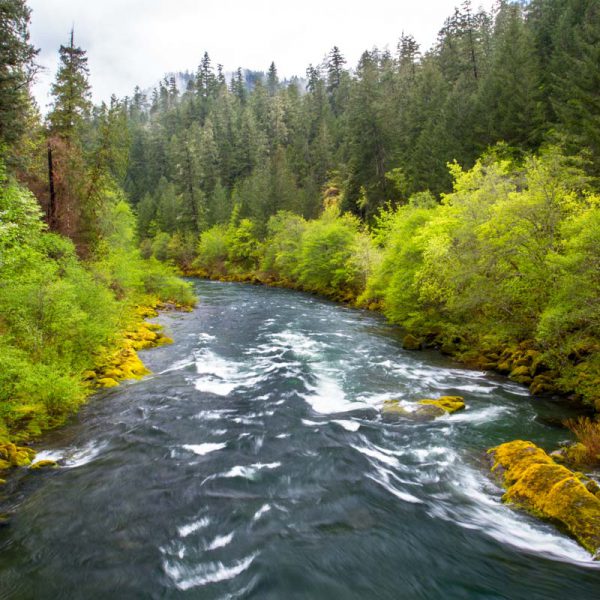Some of North Umpqua’s Last Few Summer Steelhead Face Lethal Combination of Closed Access to Upstream Coldwater Habitat, Low Flows, and Record Heat
FOR FOR IMMEDIATE RELEASE
FOR MORE INFORMATION PLEASE CONTACT:
Jim McCarthy, WaterWatch of Oregon, 541-941-9450, jim@waterwatch.org
Kirk Blaine, Steamboaters, 307-299-7834, steamboatersboard@gmail.com
*River advocates are preparing to document another fish kill if it materializes and will be available to reporters for comment and to provide photos and video.*
Winchester, OR – Just days after a sloppy, penny-pinching repair effort at Winchester Dam triggered a massive kill of the North Umpqua River’s Pacific lamprey, river advocates are warning that some of the last few summer steelhead and spring Chinook salmon left in the North Umpqua may become the next aquatic life to die, trapped in the warm water below the dam as a heat wave scorches the region.
On Monday August 7th, the fish ladder at Winchester Dam near Roseburg closed until August 28th to allow reservoir drawdown and structural repairs at the 450-foot wide, 17-foot tall, 130-year-old wood, steel, and concrete structure maintained solely for the private recreational use of approximately 110 landowners surrounding the reservoir. The move also closed off access to migratory fish seeking 160 miles of high quality coldwater salmon and steelhead habitat upstream. Soon after, the National Weather Service issued an Excessive Heat Warning for the region for August 14th through 17th, forecasting “Dangerously hot conditions with temperatures between 102 to 108 degrees expected. A few west side valleys will reach up to 111 degrees.”
The drawdown repair option was chosen by dam owners specifically for its cheapness compared with other common repair options, despite its known high impacts to the North Umpqua’s aquatic life, habitat, and drinking water supplies. State and federal officials chose to approve the owners’ repair proposal, despite having the authority to require lower impact repair methods, despite repeated formal pleas from river advocates to avoid the anticipated mass mortality of aquatic life by requiring a lower impact repair alternative, and despite a well documented history of mass mortality of aquatic life during previous dam repairs using the same drawdown method.
Earlier this year, Oregon Department of Fish and Wildlife (ODFW) officials declined to answer river advocates’ formal request to use their authority to require a less harmful repair alternative maintaining upstream fish migration ¬– only weeks before collapsing summer steelhead numbers spurred ODFW to shut all angling in the North Umpqua from August through November. The ignored petition (linked below) stated in part: “The North Umpqua in August typically experiences low flows and high temperatures, which cause significant stress and mortality among native fish, as well as angling closures in recent years. In addition, the river reach below Winchester Dam is generally lacking in cold water refugia, so fish stranded below the dam by the project’s interruption period will be even more likely to be highly stressed or die before they can reach the protection of cold water. Migratory fish crowded into refugia downstream by this passage interruption may be more susceptible to predation, poaching, and the spread of disease. The drawdown of the reservoir before repair may draw additional fish towards the dam by temporarily increasing river flows downstream, then strand these fish for three weeks in low, hot water below an impassable dam. Any fish that survive being bottled up against the dam will then face even lower and hotter water when reservoir refill depletes downstream flows.”
Last week, officials from state, federal, and tribal wildlife agencies combed vast stretches of drying reservoir sediments above the dam in an emergency effort to stem losses from a massive lamprey kill sparked by the controversial dam repair effort. This week, the emergency teams have given way to flocks of birds gathered to feast on dead lamprey carpeting the reservoir flats. The death toll for the North Umpqua’s native aquatic life due to the repairs remains to be calculated, but it is expected to be staggering.
Winchester Dam is a derelict former hydropower facility and one of the state’s highest priorities for fish passage correction. According to the Oregon Department of Fish and Wildlife, the dam blocks or impedes access to 160 miles of high quality habitat for native fish even when the fish ladder is in operation. River advocates from a coalition of fishing, conservation, and whitewater groups have been working for years to raise alarm bells with government officials over the Winchester Water Control District’s chronic non-compliance with state and federal repair permitting, engineering, water quality, and dam safety requirements as well as their disregard for protections for fish and wildlife despite the essential habitat importance of the North Umpqua for salmon and steelhead.MORE INFORMATION PLEASE CONTACT:
Jim McCarthy, WaterWatch of Oregon, 541-941-9450, jim@waterwatch.org
Kirk Blaine, Steamboaters, 307-299-7834, steamboatersboard@gmail.com
Winchester, OR – This week, officials from state, federal, and tribal wildlife agencies are combing vast stretches of drying reservoir sediments above Winchester Dam on the North Umpqua River in an effort to stem losses from a massive fish kill sparked by a controversial ongoing dam repair effort. In particular, upwards of hundreds of thousands of young Pacific lamprey are feared lost due to the failure of Winchester Water Control District, the owners of the dam, to meet state and federal requirements for rescuing aquatic life stranded during a reservoir dewatering. This dewatering began around midnight on Monday August 7th in order to provide work crews with three weeks of structural access for repairs. This drawdown repair option was chosen by dam owners specifically for its cheapness compared with other common repair options, despite its known high impacts to the North Umpqua’s aquatic life, habitat, and drinking water supplies. State and federal officials chose to approve the owners’ repair proposal, despite having the authority to require lower impact repair methods, despite repeated formal pleas from river advocates to avoid the anticipated mass mortality of aquatic life by requiring a lower impact repair alternative, and despite a well documented history of mass mortality of aquatic life during previous dam repairs using the same drawdown method.
The death toll for the North Umpqua’s native aquatic life remains to be calculated, but it is expected to be staggering. According to public records, during a 2013 reservoir drawdown and subsequent scramble by wildlife officials and the Cow Creek Band of Umpqua Tribe of Indians to rescue fish from the carelessness of the Winchester Dam owners, The Cow Creek Tribe “estimated conservatively that for every one live lamprey salvaged there were approximately 10 dead in the same area (about 1ft2).” The dam repair plan calls for the approximately 7,500 foot long reservoir to remain dewatered from August 7th until August 28th.
“This massive fish kill could have been avoided, but wildlife officials chose to put the stinginess of a handful of well-connected private lake owners over their mission to protect our invaluable fish and wildlife.” said Jim McCarthy, Southern Oregon Program Director for WaterWatch of Oregon, and a leader of the coalition of fishing conservation, and whitewater groups to end the harm caused by Winchester Dam. “River advocates knew this would happen and pleaded with the Oregon Department of Fish and Wildlife and other agencies in charge to reject the low-cost, high-risk repair proposal of the dam owners, but we were ignored. This latest disaster and the public records from their past dam repair disasters make plain that Winchester Dam’s owners feel free to ignore regulations protecting people, fish, and water quality. It’s one of the many reasons this dam must be torn down, and we are committed to making that happen.”
“This is precisely what happened the last time they worked on the dam in 2013,” said Stan Petrowski, veteran Umpqua River advocate and President/Director of the
South Umpqua Rural Community Partnership. “There was considerable effort to hush hush the entire thing. There were thousands upon thousands of lamprey deaths. This will continue to recur again and again as long as that dam remains in place.”
“I am extremely disappointed in the current situation at Winchester Dam,” said Kirk Blaine, President of the Steamboaters and Southern Oregon Coordinator for Native Fish Society. “ODFW knew this would happen and they said yes for the convenience of the landowners who want to maintain their private water ski lake at the lowest cost possible. Just as ODFW said yes, allowing the landowners to trap our last few summer steelhead and spring Chinook below the dam to bake for three weeks in warm waters. This travesty of fish mortality is unfolding despite an available repair alternative that would have maintained the reservoir pool limiting lamprey mortality and providing continued fish passage during construction, allowing our last few remaining fish the best chance to survive the migration to cold water spawning habitat above the dam.”
Winchester Dam is a derelict former hydropower facility now owned and maintained solely to provide a private water ski lake for approximately 110 landowners surrounding the reservoir pool. River advocates from coalition of fishing, conservation, and whitewater groups have been working for years to raise alarm bells with government officials over the Winchester Water Control District’s chronic non-compliance with state and federal repair permitting, engineering, water quality, and dam safety requirements as well as their disregard for protections for fish and wildlife despite the essential habitat importance of the North Umpqua for salmon and steelhead. According to the Oregon Department of Fish and Wildlife, Winchester Dam is one of the state’s highest priorities for fish passage correction, and blocks or impedes access to 160 miles of high quality habitat for salmon and steelhead.
River advocates will be documenting the disaster and available to reporters for comment and to provide photos and video.
River Advocates Petition to ODFW Warning of Mass Lamprey Mortality
https://waterwatch.org/wp-content/uploads/2023/02/Winchester_Dam_Passage_Petition_02_26_23.pdf
Public Records/Agency Notes from Past Winchester Dam repairs:
https://waterwatch.org/wp-content/uploads/2023/08/WInchester-Draw-Down-Note-Synthesis-Final.docx
https://waterwatch.org/wp-content/uploads/2023/08/WInchester-Draw-Down-Note-Synthesis-Final.docx
https://waterwatch.org/wp-content/uploads/2023/08/Winchester-Dam-2013-Drawdown-Agency-Meeting2-Notes.docx
Winchester Dam Repair Permits
ODFW Fish Passage Authorization:
https://waterwatch.org/wp-content/uploads/2023/08/ODFW_Fish_Passage_Authorization_Winchester_Dam_Repair_PA-17-0138.pdf
DEQ 401 permit:
https://waterwatch.org/wp-content/uploads/2023/08/20230718_DEQ_401_WQC_2018_505_1.pdf
NOAA Biological Opinion:
https://waterwatch.org/wp-content/uploads/2023/08/2023_07-20_WinchesterDam_WCRO-2022-02717.pdf
Army Corps permit:
https://waterwatch.org/wp-content/uploads/2023/08/20230726-NWP-Verification-Ltr-NWP-2018-505-1.pdf
Revised WWCD removal-fill application (last one before Corps and DEQ issued permits):
https://waterwatch.org/wp-content/uploads/2023/07/Joint-Permit-Application-DEQ-Submittal_20230707-Updates.pdf


